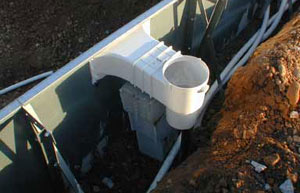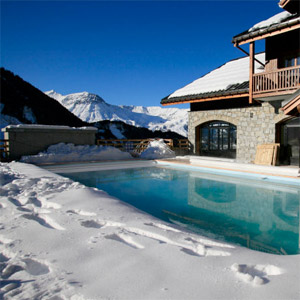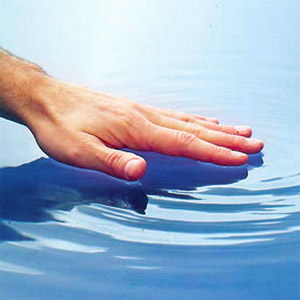 FAQ - Swimming Pool Online advice and recommendations
FAQ - Swimming Pool Online advice and recommendations Installation guide for pool kit
Installation guide for pool kit  Installation of plumbing and technical shelter
Installation of plumbing and technical shelter Installation of plumbing and technical shelter
Installation guide for pool kit
The composition of a pool kit
Tracing and excavation of your pool
Fitting the panels of your pool kit
Applying concrete and bottom screed
Installation of plumbing and technical shelter
Installation and fitting of sealed liner and filling your pool
We recommend the calculation of hydraulic requirements for each individual pool configuration. This way, it is possible to determine the capacity of the pump and required diameter to optimise your pools operational capacity. Calculate a total recycling of pool water every 4 hours, for example, 15m3/h for a pool with 60 m3.
It is generally recommended that the PVC piping outlet for the skimmer is a minimum of 50 mm in diameter.
Concerning polyethylene ducts: very frequently used, these ducts are simple, flexible and easy to use, however, they must not be exposed to sunlight. Ultraviolet rays degrade this material with time.
Polyethylene duct is conditioned in long rolls and allows an installation with a minimum of connectors.


This is the best moment to install your Swimming pool lighting built into the pool wall, (or perhaps your pool kit already includes the reservations for lighting).
If the opening for your lighting projector is pre-cut by the manufacturer, installation is easy. If you must cut your own opening, follow the below instructions :
Using the O-ring of your ASTRAL lighting projector for concrete walled pools as a template, draw the parameter of the opening to be cut with a marker on your steel panel.
Drill a hole in the center of the hole. Using an electric saw with a steel cutting blade, cut from the center point out to the circles outline, and cut out the circle.
Check the projector fits the hole. Spray on a cold galvanising product on the circles edges and paint with an anti-rust paint.
Install the projector and pull a duct in which the power cable will be placed. The cable should be connected by a qualified electrician respecting norms.




If your step structure is complete with a hydro jet or discharge nozzle :
To install these elements, you must open the insert holes using a hole saw of the correct diameter.
The nozzles and sockets are supplied with O-rings that are designed for use on the two sides of the step structure. Screw the locking bolt totally.
You can now connect the pipes and water circulation system to the water supply.
Before filling in all trenches, check the whole piping network under water pressure.
Next step : Installation and fitting of sealed liner and filling your pool
The composition of a pool kit
Tracing and excavation of your pool
Fitting the panels of your pool kit
Applying concrete and bottom screed
Installation of plumbing and technical shelter
Installation and fitting of sealed liner and filling your pool
The installation of your pool plumbing system
We recommend the calculation of hydraulic requirements for each individual pool configuration. This way, it is possible to determine the capacity of the pump and required diameter to optimise your pools operational capacity. Calculate a total recycling of pool water every 4 hours, for example, 15m3/h for a pool with 60 m3.
It is generally recommended that the PVC piping outlet for the skimmer is a minimum of 50 mm in diameter.
Concerning polyethylene ducts: very frequently used, these ducts are simple, flexible and easy to use, however, they must not be exposed to sunlight. Ultraviolet rays degrade this material with time.
Polyethylene duct is conditioned in long rolls and allows an installation with a minimum of connectors.
Tracing your piping network
Your pipes should be installed in trenches and the outlet areas are free from stones or pointed objects. Use sand or earth without stones to fill the trench.
Mark the trenches to avoid stakes present in proximity to pipes.
Avoid crossing pipes. Do not place pipes on a surface that is not compacted. Pipes should not pass above A-frame braces or empty cavities. The piping should be installed in lengths.
Use a transition ramp between the dug trench and the evacuation. It is not possible to bend a pipe at a right angle. If a pipe is twisted, change it to avoid a leak.
Mark the trenches to avoid stakes present in proximity to pipes.
Avoid crossing pipes. Do not place pipes on a surface that is not compacted. Pipes should not pass above A-frame braces or empty cavities. The piping should be installed in lengths.
Use a transition ramp between the dug trench and the evacuation. It is not possible to bend a pipe at a right angle. If a pipe is twisted, change it to avoid a leak.

The piping linking the pool and the filtration system can be installed in two ways :
The most usual method consists of installing the piping at the same height as the connections. This entails filling of the trench with stone-free earth, sand or gravel to the required height, fit the connections and then fill the trenches to the finished level.
This method is recommended if the substance used to fill the trench is compacted (such as gravel). If the connectors have been fitted before the trench has been filled, you must be very careful when filling around the pipes and ensure they are supported and straight.
The second possible method (ref photo) consists of positioning the pipes at the base of the pool wall. This indicates vertical sections at the position of the pool connections.
When you apply your concrete the ducts will be embedded in the concrete. This protects the piping against ground movement, frost or accidental perforation. To install this method correctly use vertical risers in the appropriate sections.
The most usual method consists of installing the piping at the same height as the connections. This entails filling of the trench with stone-free earth, sand or gravel to the required height, fit the connections and then fill the trenches to the finished level.
This method is recommended if the substance used to fill the trench is compacted (such as gravel). If the connectors have been fitted before the trench has been filled, you must be very careful when filling around the pipes and ensure they are supported and straight.
The second possible method (ref photo) consists of positioning the pipes at the base of the pool wall. This indicates vertical sections at the position of the pool connections.
When you apply your concrete the ducts will be embedded in the concrete. This protects the piping against ground movement, frost or accidental perforation. To install this method correctly use vertical risers in the appropriate sections.

Installation of lighting projectors
This is the best moment to install your Swimming pool lighting built into the pool wall, (or perhaps your pool kit already includes the reservations for lighting).
If the opening for your lighting projector is pre-cut by the manufacturer, installation is easy. If you must cut your own opening, follow the below instructions :
Using the O-ring of your ASTRAL lighting projector for concrete walled pools as a template, draw the parameter of the opening to be cut with a marker on your steel panel.
Drill a hole in the center of the hole. Using an electric saw with a steel cutting blade, cut from the center point out to the circles outline, and cut out the circle.
Check the projector fits the hole. Spray on a cold galvanising product on the circles edges and paint with an anti-rust paint.
Install the projector and pull a duct in which the power cable will be placed. The cable should be connected by a qualified electrician respecting norms.
Installation of sealing pieces
Firstly, install your discharge nozzles. Put a locking nut behind the parts connection. Insert the connection into the pre-cut opening on the pool side and screw the locking nut in place using a slip joint plier. Fit the adaptors onto the connectors (the adaptors use threaded orifices or a solvent to connect polyethylene pipes).
- Threaded connectors :
Use plumber's tape (Teflon) or an adapted mastic to connect plastic connectors. .
Screw the connectors into place, first by hand, then using a slip joint plier. Do not screw too tightly.
We advise you to use PVC connections rather than more flexible polyethylene.
- Glued connections :
Some connections are designed to be stuck. In this case, use PVC glue. Begin by cleaning the area to be stuck with glue on the connector and the pipe to be stuck. Spread the glue on the circulation pipe. Be sure the glue will not spread past the connecting area.
Push the pipe into place and turn a 1/2 or 1/4 turn. Be sure that an equal layer of glue has been applied to the contact surface. Hold the connection firmly in place for a few seconds. The glue will begin to solder in place.
Polyethylene connections :
Piping is generally delivered in 30, m and 75 m rolls. Unroll the piping and inspect the piping length to ensure its good quality.
Begin to fit the connections.
Put the piping into place, beginning with the skimmer in both the evacuation and its trench.
Connect the skimmer.
Use two metallic slip joint pliers to tighten the connection at the extremity of the piping (this ensures equal force when tightening the connection).
Repeat this operation on each connection on the entire network of piping.
- Threaded connectors :
Use plumber's tape (Teflon) or an adapted mastic to connect plastic connectors. .
Screw the connectors into place, first by hand, then using a slip joint plier. Do not screw too tightly.
We advise you to use PVC connections rather than more flexible polyethylene.
- Glued connections :
Some connections are designed to be stuck. In this case, use PVC glue. Begin by cleaning the area to be stuck with glue on the connector and the pipe to be stuck. Spread the glue on the circulation pipe. Be sure the glue will not spread past the connecting area.
Push the pipe into place and turn a 1/2 or 1/4 turn. Be sure that an equal layer of glue has been applied to the contact surface. Hold the connection firmly in place for a few seconds. The glue will begin to solder in place.
Polyethylene connections :
Piping is generally delivered in 30, m and 75 m rolls. Unroll the piping and inspect the piping length to ensure its good quality.
Begin to fit the connections.
Put the piping into place, beginning with the skimmer in both the evacuation and its trench.
Connect the skimmer.
Use two metallic slip joint pliers to tighten the connection at the extremity of the piping (this ensures equal force when tightening the connection).
Repeat this operation on each connection on the entire network of piping.


Technical shelter
A hack saw is an ideal tool to use when working with polyethylene.
Be sure to make clean, 90° cuts. This will make assembly easier.
Polyethylene piping can be very rigid, except in warm conditions. This is why at times it is difficult to fit a connector or it gets broken by forcing too hard. To avoid this, heat the end of your pipe with a propane blow torch.
Hold the blow torch at a distance of 15 to 30 cm from the pipe, pass the flame over the pipe using circular movements, just till it becomes more flexible. Be sure to move the blow torch around as if you leave it in the same spot too long it could go on fire or deform.
When the pipe is flexible, slip the adapter or connection on without forcing. Hold in place for a moment while the pipe cools (this applies to all connections and adaptors for the kit).
Tighten the screws of the pipe clamp as follows :
- place the first pipe collar, screw above, towards you,
- place the second pipe collar, screw below, towards you
Using a screwdriver, tighten progressively the high collar and after the low collar.
Once all connections have been made, check all the collars have been correctly tightened. As the pipe cools, it will contract, tighten once again the collars.
To finish, you may need to use vertical risers to connect pipes in the trench to equipment. You should prepare a reservation for each connection allowing the vertical risers to be easily inserted into the concrete surrounding the pool parameter.
PVC piping
This method associates rigid and flexible PVC. All connections are stuck by glue.
The procedure is the same as for polyethylene, pipe collars are not used. To connect pipes, the procedure is the same.
Use a solvent to clean all surfaces that are to be stuck. Apply a generous layer of glue to the two surfaces.
Fit the pipes together, turning and pushing simultaneously. Hold in place till the glue sets.
Be sure to use the right glue. PVC for rigid pipes is not the same composition as PVC glue for flexible pipes.
Be sure to make clean, 90° cuts. This will make assembly easier.
Polyethylene piping can be very rigid, except in warm conditions. This is why at times it is difficult to fit a connector or it gets broken by forcing too hard. To avoid this, heat the end of your pipe with a propane blow torch.
Hold the blow torch at a distance of 15 to 30 cm from the pipe, pass the flame over the pipe using circular movements, just till it becomes more flexible. Be sure to move the blow torch around as if you leave it in the same spot too long it could go on fire or deform.
When the pipe is flexible, slip the adapter or connection on without forcing. Hold in place for a moment while the pipe cools (this applies to all connections and adaptors for the kit).
Tighten the screws of the pipe clamp as follows :
- place the first pipe collar, screw above, towards you,
- place the second pipe collar, screw below, towards you
Using a screwdriver, tighten progressively the high collar and after the low collar.
Once all connections have been made, check all the collars have been correctly tightened. As the pipe cools, it will contract, tighten once again the collars.
To finish, you may need to use vertical risers to connect pipes in the trench to equipment. You should prepare a reservation for each connection allowing the vertical risers to be easily inserted into the concrete surrounding the pool parameter.
PVC piping
This method associates rigid and flexible PVC. All connections are stuck by glue.
The procedure is the same as for polyethylene, pipe collars are not used. To connect pipes, the procedure is the same.
Use a solvent to clean all surfaces that are to be stuck. Apply a generous layer of glue to the two surfaces.
Fit the pipes together, turning and pushing simultaneously. Hold in place till the glue sets.
Be sure to use the right glue. PVC for rigid pipes is not the same composition as PVC glue for flexible pipes.


Steps
If your step structure is complete with a hydro jet or discharge nozzle :
To install these elements, you must open the insert holes using a hole saw of the correct diameter.
The nozzles and sockets are supplied with O-rings that are designed for use on the two sides of the step structure. Screw the locking bolt totally.
You can now connect the pipes and water circulation system to the water supply.
Before filling in all trenches, check the whole piping network under water pressure.
Next step : Installation and fitting of sealed liner and filling your pool
Photos non-contractual











